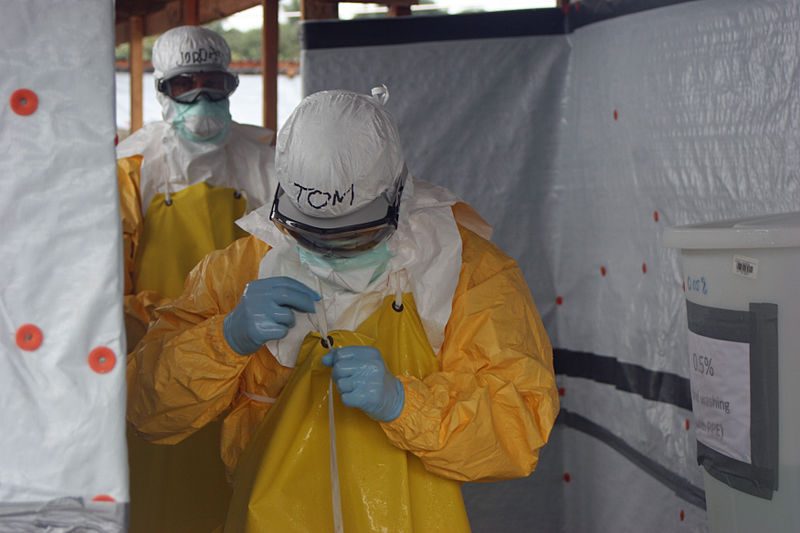Thursday, October 16, 2014
Defensive Gun Use and Ebola
The possibility of infection during and after a defensive gun use has long been a matter of concern. On the positive side, guns give you some "stand off" distance; they are effective without coming into direct contact with the attacker. On the negative side, if you have to shoot someone, there will be lots of blood and other bodily fluids, so the chances of infection become much higher.
I write this from the Dallas/Fort Worth Metroplex, where my first grandchild was born in the same hospital complex that treated the first U.S. Ebola patient, Thomas Duncan, from Liberia. He was born while Duncan was being treated, before Duncan died. That complex was where the first U.S. citizen contracted the disease in the United States. She is Nina Pham, a health care worker who treated Duncan. This morning, a second health care worker has been diagnosed with the disease.
The protective protocols used at the hospital failed. No one knows how the health care workers were infected. But Ebola is just one, although extremely deadly, type of infection. Others, much more common, are HIV, Hepatitis-C, and the whole spectrum of infectious disease that the human body is subject to.
Ebola or not, should a defender render first aid to someone that they have shot? My answer is that it is an individual choice, but be aware of the substantial risks that follow such activity.
First, consider the possibility that the individual may continue the fight. Sometimes people are merely stunned, or momentarily debilitated; sometimes an assailant may "play possum", in order to draw the defender in. Coming in physical contact with them can be extremely perilous.
Second, there is a serious chance of infection. Blood and bodily fluids are likely to be spattered about in copious amounts. The chances of you receiving a small cut or abrasion during the interaction are high, making the risk of infection greater. A skinned knee from taking cover becomes significant.
Criminals and/or drug addicts are not known for their scrupulous attention to hygiene and sanitation. They have a higher incidence of infectious disease than the rest of the population. You shot them because they were a deadly threat; risking your life to provide aid is not a moral imperative. Personally, I would call 911, and have the professionals who are equipped with the latest prophylactic equipment and techniques handle the situation.
Chances of infection can be reduced. As always, avoid shooting if possible. No shooting, much less chance of infectious bodily fluids spread around the area where you are. Second, keep your distance! The closer the attacker is to you, the greater the chance of infection.
These two dynamics tend to work against each other. If you avoid shooting, the aggressor may come closer. Defensive display laws such as those passed in Montana and Arizona, or the new law allowing greater protection for people displaying a firearm or firing a warning shot in Florida seem farsighted and prudent.
The military uses numerous barriers to prevent attackers from closing quickly. The zoning codes that prevent protective walls around most homes in the United States, seem short sighted in this light. Some sort of stand-off barrier may be prudent at house entrances.
My late friend George (Tex) Ferguson, had a reinforced porch with a locked door and a doorbell. When someone rang the doorbell, he could look at them from 15 feet away, and decide whether to allow them to come closer. I have seen some homes with a fenced yard utilize a similar system on the fence gate. It is a good addition to any home's security system. Modern cameras and intercoms make the system even more usable. Think of it as an automated doorman.
A high risk of infection may require us to reconsider the utility of warning shots, at least in more rural areas where intruders may be spotted at greater distances, and the dangers to bystanders are small.
If you have the misfortune of having to shoot someone, keeping your distance from their body helps to minimize the chance of infection. Treat any blood or other bodily fluids as potential sources of infection as well.
If Ebola cases continue to accumulate in the United States, everyone will be wearing surgical masks, at a minimum; gas masks and or respirators are likely, and movement will be greatly reduced. The very nature of our understanding of what is a "deadly threat" will be changed.
I pray that it does not happen.
©2014 by Dean Weingarten: Permission to share is granted when this notice is included.
Link to Gun Watch
Subscribe to:
Post Comments (Atom)







1 comment:
Talk about timing.
A nurse that treated that guy in Dallas, took a flight, passed through Chicago and into Cleveland, then she traveled by car to Akron and visited Kent State University, flys back to Dallas and has Ebola.
Been all over TV news here since I started watching just before noon and hasn't stopped at 4pm. Cleveland reporter so upset, she couldn't get the words out of her mouth and kept stumbling her speech till they cut away.
All over the net too.
Post a Comment